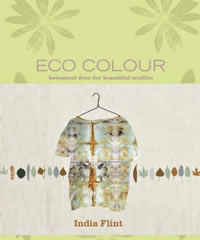Eco Colour: Botanical dyes for beautiful textiles book
Resource Review

Description
Eco colour: Botanical dyes for beautiful textiles by Australian textile artist India Flint is based on her 20 years of experience and experimentation in natural dyeing techniques. It is aimed at those new to dyeing as well as textile professionals looking to extend their skill.
Curriculum/Qualifications links
While this book is particularly relevant for teachers working in the Technology, Science and Art areas, it also directly links to values stated in The New Zealand Curriculum: 'Students will be encouraged to value ecological sustainability, which includes care for the environment'.
Content
The book is divided into eight sections:
- 'Natural' dyes – a context
Collecting plants – a protocol - Equipment and a place to work
Harvesting and storing plants for dyeing - Some traditional dye materials
- Preparing to dye
Mordants
Processing plant dyes - Eucalyptus dyes
Beyond the eucalyptus
Ice-flower dyes
Fruits and berries - Cold-bundled eco-prints
Non-eucalyptus eco-prints using hot-bundling
Hapa-zome – beating colour into cloth
Dyeing wool yarn and sliver
Multi-coloured yarns
Printing with plant dyes
Using shibori techniques and layered dyeing
Resists
Solar dyeing
Mud and cow patties - The importance of water/time
Caring for cloth
Disposal of wastes - References/Further reading/About the author
Ease of use
The book is attractively laid out with photographs illustrating resources and outcomes, and is structured so that the reader can dip into any section – whether it's Testing for acids and alkalis, The true cost of synthetic dyes, or Methods for dyeing multi-coloured yarns.
Wendy Webb, Textiles Technology teacher at Gisborne Girls' High School, already incorporated dyeing in some of her units (see the Kiwi Made classroom practice case study) and was keen to experiment with eco-friendly materials and methods. She purchased India's book on the recommendation of Sandy Heffernan, Head of the Design School at Massey University, and worked with her students in trialling some of the techniques. Wendy says that the book's beautiful appearance made her students want to pick it up and read it, "and because it looked different to other books, it wasn't just an encyclopaedia. The illustrations really inspired the students, when they saw the lovely cloth she had created".
Rating
Wendy and her students found India's knowledge base useful, and one student has decided to concentrate on this sort of dyeing in her project. Wendy adds that India's record-keeping system, in which she illustrates the products and mordants used in an experiment and attaches samples of the cloth, was helpful in showing her students the importance of documenting their work.
Accessibility
The book can be ordered through most New Zealand book stores or online, and is available in some public libraries.
Murdoch Books Pty Limited
Published 2008
Hardcover format
240 pages

